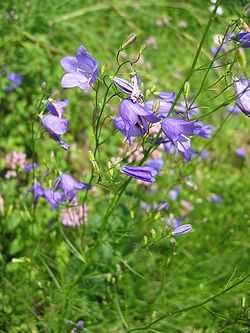Campanula rotundifolia
| Harebell | |
|---|---|
 | |
| Scientific classification | |
| Kingdom: | Plantae |
| (unranked): | Angiosperms |
| (unranked): | Eudicots |
| (unranked): | Asterids |
| Order: | Asterales |
| Family: | Campanulaceae |
| Genus: | Campanula |
| Species: | C. rotundifolia |
| Binomial name | |
| Campanula rotundifolia L. | |
Campanula rotundifolia (harebell) is a rhizomatous perennial flowering plant in the bellflower family native to temperate regions of the Northern Hemisphere.
In Scotland, it is often known as the bluebell. Elsewhere in Britain, bluebell refers to Hyacinthoides non-scripta, and in North America, bluebell refers to Virginia bluebell.
Description

Basal leaves are rounded to heart-shaped, usually slightly toothed, with prominent hydathodes, and often wither early. Leaves on flowering stems are long and thin and the upper ones are unstemmed.
Flowers have five violet-blue, pink, or white petals fused together into a bell shape, about 15 mm (0.6 in) long and five long, pointed green sepals behind them. The petal lobes are triangular and curve outwards. They bloom on long thin stems either singly or in loose clusters from late spring to autumn. The flowers are pollinated by bees, but can self-pollinate.
The seeds are produced in a capsule about 3–4 mm (0.1–0.2 in) diameter. The seeds are released by pores at the base of the capsule. Seedlings are minute, but established plants can compete with tall grass.
Like other Campanulas, all parts of the plant exude white latex when injured or broken.
Adaptations
If exposed to moist cool conditions during the summer no pause in vegetative growth is exhibited,[citation needed] which suggests that temperature is a limiting factor.[citation needed] C. rotundifolia is more inclined to occupy climates that have an average temperature below 0°C in the cold months and above 10°C in the summer.[1]
Habitat
Harebells are native to dry, nutrient-poor grassland and heaths in Britain, northern Europe, and North America. The plant often successfully colonises cracks in walls or cliff faces and dunes.
Forms
The species is very variable in form.
It occurs as tetraploid or hexaploid populations in Britain and Ireland, but diploids occur widely in continental Europe.[2] In Britain, the tetraploid population has an easterly distribution and the hexaploid population a westerly distribution, and very little mixing occurs at the range boundaries.[3]
Culture
The Harebell is dedicated to Saint Dominic.
In 2002 Plantlife named it the county flower of Yorkshire in the United Kingdom.[4]
William Shakespeare makes a reference to 'the azured hare-bell' in Cymbeline
- With fairest flowers,
- Whilst summer lasts, and I live here, Fidele,
- I'll sweeten thy sad grave: thou shalt not lack
- The flower that's like thy face, pale primrose, nor
- The azured hare-bell, like thy veins; no, nor
- The leaf of eglantine, whom not to slander,
- Out-sweeten’d not thy breath.[5][note 1]
John Clare draws attention to the brightness of the flowers of the Harebell in the dark of the wood.
- By the hare-bell 's hazure sky,
- (Like the hue of thy bright eye;)
- That grows in woods, and groves so fair,
- Where love I'd meet thee there.[6]
Christina Rossetti (1830–1894)wrote a poem entitled 'Hope is Like A Harebell'
- Hope is like a harebell, trembling from its birth,
- Love is like a rose, the joy of all the earth,
- Faith is like a lily, lifted high and white,
- Love is like a lovely rose, the world’s delight.
- Harebells and sweet lilies show a thornless growth,
- But the rose with all its thorns excels them both.[7]
Emily Dickinson uses the harebell as an anology for desire that grows cold once that which is cherished is attained.
- Did the Harebell loose her girdle
- To the lover Bee
- Would the Bee the Harebell hallow
- Much as formerly?
- Did the paradise - persuaded
- Yield her moat of pearl
- Would the Eden be an Eden
- Or the Earl -an Earl[8]
Notes
- ↑ In Jessica Kerr's and Opelia Dowden's Shakespeare's Flowers published in 1970 they infer that Shakespeare was actually making reference to a bluebell (Hyacinthoides non-scripta)
References
- ↑ Shetler SG. 1982 Variation and evolution of Nearctic harebells (Campanula subsect. Heterophylla). Phan. Monogr. 11. 1-516 (1982)- En Abstr. in Excerpta Bot., A, 39(1): p.20 (1982).
- ↑ McAllister, H.A. 1973. The experimental taxonomy of Campanula rotundifolia L. Ph.D. Thesis, University of Glasgow
- ↑ Stevens, C.J., Wilson, J. and McAllister, H.A., Biological Flora of the British Isles: Campanula rotundifolia. Journal of Ecology, 2012, 100, 821-839
- ↑ Plantlife website County Flowers page
- ↑ William Shakespeare, Cymbeline (iv. 2), Arviragus speech
- ↑ John Clare,Poem, By a Cottage Near a Wood, written at High Beach, Epping, 1837–1841, and at Northborough, 1841
- ↑ Christina G Rossetti, A Nursery Rhyme Book, Macmillan and Co., London, New York (1893)
- ↑ Emily Dickinson, Did the Harebell loose her girdle,Volume: Complete Poems of Emily Dickinson, 1st published in 1955
Books
- R and A Fitter, The Wild Flowers of Britain and Northern Europe, Collins, 1974
External links
| Wikimedia Commons has media related to Campanula rotundifolia. |
| Wikispecies has information related to: Campanula rotundifolia |
- USDA Plants Profile
- Native Plant Identification Network
- Paghat's Garden
- Missouri Plants
- Montana Plant Life
- Robert W. Freckman Herbarium — University of Wisconsin, Stevens Point
- Nature of California — Las Pilitas Nursery
- Vascular Plants of the Gila Wilderness
- CalPhotos